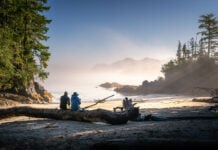In the spring of 1994, a friend wanted a ride to buy a used pickup. We left the remote camp where we ran outdoor education programs and drove to a remote warehouse near the Molalla River. Three guys came out. One was selling the truck. Then he introduced his co-workers, saying, “We are Lightning Paddles.”
I’d been using one of their paddles since I started kayaking six years before. I hadn’t realized the “Colton, OR” printed on the blade was just a few miles from where I worked.
The Pacific Northwest’s once-thriving paddlesports manufacturing industry is vanishing
Lightning Paddles, of course, is gone. So is Necky, which made sea and whitewater kayaks on Vancouver Island before being bought out by Johnson Outdoors. Pygmy Kayaks in Port Townsend, a legendary maker of stitch-and-glue kayaks, shut down during the pandemic. Saltwood Paddles—once five miles from my front door—is no more. Current Designs, started in the ‘70s on Vancouver Island by Brian Henry, was sold in 1999 to Wenonah Canoes, which moved the operation to Wisconsin. It was recently sold again. Pacific Water Sports closed in 2003.
The latest disappearance is Seaward Kayaks, the last manufacturer of touring kayaks on Vancouver Island, which shut down its Chemainus operation in the summer of 2024 after almost 40 years in business.

Even the ones that survive have moved. Werner Paddles merged with Jackson Kayak and is moving operations from Sultan, Washington, to Tennessee. Eddyline Kayaks left Anacortes, Washington, for Siloam Springs, Arkansas. What’s left of Pacific Northwest paddlesports manufacturing is slim: Kokatat in Arcata, Sterling Kayaks in Bellingham, Delta Kayaks in British Columbia, and Immersion Research in Hood River.
There is much to both lament and celebrate about the flight of paddling manufacturing from the Northwest. I certainly don’t begrudge Pygmy’s John Lockwood, Eddyline’s Tom Derrer, or Current Designs’ Brian Henry their well-earned retirements. And one community’s loss is another’s gain. I’m sure locals were excited in Siloam Springs and Sparta, Tennessee, when Eddyline and Werner started production there.
Of course, companies close, move and merge all the time, from the mergers of Mercedes-Benz-Chrysler to Facebook-WhatsApp and Burlington Northern-Santa Fe. Mergers aren’t just for railroads, car companies or Mark Zuckerberg.
Still, I want my local paddling industry to thrive.
Knowing your gear was made nearby, by hands you’ve shaken, creates connections that tie you to a place.
The loss of local manufacturing is about three overlapping trends: demographics, culture and how we make and buy things. Time waits for nobody. Many shutdowns, mergers and moves happen when a founder retires. Lockwood, Henry, Derrer, Pacific Water Sports’ Lee Moyer, and Bob Collmer of Lightning are all baby boomers. They started their companies in the first golden age of sea kayaking in the 1970s and ‘80s, making handcrafted products during the rapid expansion of kayaking and the outdoor adventure business. With new leadership, ties to place and business models evolve.
And paddling has changed. Seaward made glass touring boats. Pygmy’s kits were for builders. Both require combinations of money, space to store and build, and a hankering for trips that take days or weeks. Much ink, including my own, has been spilled analyzing the evolution of how we paddle (paddlingmag.com/0180). While overall participation in paddling is up, more paddlers today are day trippers. The number of outdoor enthusiasts getting outside for long trips is dropping, according to the Outdoor Industry Association, and with it, so goes the number of paddlers shopping for an expedition kayak.
Manufacturing has also shifted toward thermoform and plastic, which cost less but also yield smaller margins. Shared manufacturing—like at Confluence, which owns six paddlesports brands—helps cut costs. The “play the sea” trend—whitewater moves in surf and rock gardens—favors plastic boats. Packrafts are surging. Evolution requires a lot of resources for R&D, which is expensive and risky since you might spend a lot of time developing something new and innovative that might not sell (remember the Perception Mr. Clean?).
The third trend is one we’ve known about since the 1970s: manufacturing in North America has declined since the end of the post-WW2 boom in the late 1970s. Then came offshoring and the decline of high-paying manufacturing jobs in the U.S. and Canada. These days, it’s hard to tell what country a company is from when American Fords are made in Mexico, Canada and the U.S., and Japanese Toyotas are made in 26 countries, including 10 places in the U.S.
It’s the same story for many paddlesports brands.
Globalization has plenty of discontents, and I’m often one of them. It’s lowered prices and created scale—but it’s also stripped away some of what makes paddling culture rich and rooted. Knowing your gear was made nearby, by hands you’ve shaken, creates connections that tie you to a place.
And there’s more at stake than community. There’s power. Jobs that go elsewhere reduce our clout. As I wrote years ago in this magazine, the outdoor industry is an economic behemoth that should have a lot more influence than it does. In 2024, the U.S. outdoor industry was responsible for $1.2 trillion in economic output and five million jobs.
But many of those jobs are seasonal or low-paying. Think of your seasonal, itinerant paddling instructors, river shuttle drivers, ski lift operators and the various services we use on our adventures: food, gas and the motel on the way to the river. To build an outdoor economy that sustains us and gives us the clout to protect rivers and seas where we paddle, we need to design and make things. The good-paying jobs often aren’t in the service industry; they’re in designing and making stuff.
Good-paying manufacturing jobs are only part of the story. The other piece of the puzzle is keeping business HQs local. Product design, engineering, marketing, accounting and all the things that go into making a business work are also high-paying outdoor jobs. They’re lost when a company like Seaward shuts down, or they shrink or leave town when a small business becomes part of a larger one. Even if manufacturing has gone elsewhere, keeping a company’s headquarters in North America matters for our economic and political pull.
It’s easier to advocate for clean water when you have a trillion-dollar industry and good-paying jobs that depend on it.
Of course, it’s not all economics. Knowing the people who make the stuff you paddle with has a huge intangible value. At a local event, someone once asked about my paddle. I laughed and pointed to Richard, the designer, sitting right beside me. Those connections make paddling a community, not just a sport.
My next kayak is another story. Three of us need new kayak polo boats, which are handmade by two retired guys in Edmonton, Alberta, with no website. In addition to the kayaks came an invitation to a kayak polo tournament and the puzzle of how to get the kayaks back down to Portland.
Feels a lot like Lightning Paddles, circa 1994. Maybe they’ll also sell us a truck.
Neil Schulman’s first paddle was a Lightning, made in Colton, OR. His last purchase was a Saltwood Reggie, one of the last made in Portland.
Don’t it always seem to go that you don’t know what you’ve got till it’s gone. | Feature photo: Kiliii Yuyan



 This article was published in Issue 73 of Paddling Magazine.
This article was published in Issue 73 of Paddling Magazine. 





Also still in the PNW – NC Kayaks in Tacoma, WA and now Mocean Kayaks in Burlington, WA.
What are the tax rates on businesses in your area?